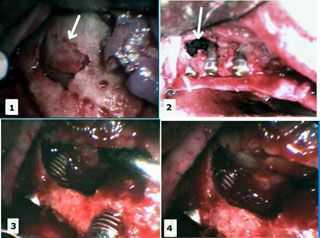Before and after photos on sinus lift elevation bone grafts and dental implants performed in our dental implants office

This CT (CAT) scan is used for planning dental implants in the upper and lower jaws, the maxilla and mandible. This shows the volume of bone into which the implants may be placed.
Notice the absence of bone in the upper jaw. This will require a sinus lift surgery and bone graft, also called a sinus elevation or augmentation, before placement of dental implants.

Dental implant oral surgery with sinus lift elevation and bone graft. How to pictures. A 64 year-old female presented with five very loose maxillary anterior teeth and no maxillary posterior teeth. She wanted fixed dental crowns. Four years earlier this patient had six osseointegrated dental implants placed in the mandible with a fixed dental crowns bridge. The x-ray (not shown) showed an atrophic maxilla with 4mm of bone, which required a bone graft and sinus lift for dental implants. The treatment plan included teeth extractions of all anterior teeth, sinus lift with platelet-rich plasma (PRP), and simultaneous dental implant placement. Photo 1 of 5.

Dental implant oral surgery with sinus lift elevation and bone graft. How to Pictures. 1) A Platelet Concentration Specialist obtained 60 cc of the patients’ own blood and 2) centrifuged it to obtain 6-8 cc of platelet-rich plasma (PRP) and 10 cc of platelet-poor plasma – fibrin glue. 3) The PRP was mixed with the patients’ bone and freeze-dried bone, and then activated with thrombin. This mixture was then used as bone graft material for the sinus lift in and around the dental implants to facilitate osseointegration. Photo 2 of 5.

Dental implant oral surgery with sinus lift elevation and bone graft. How to Pictures. 1) – 3) A sinus lift was performed by opening a small “window” into the sinus without perforating the Schneiderian Membrane. The window was gently elevated along its superior fracture line and the membrane peeled off of the sinus floor, creating a new, more superior sinus floor. 4) The dental implants were carefully placed by the Oral Surgeon to make sure they were stable. Notice that the width of the alveolar ridge was inadequate for the implants necessitating the PRP graft. The most distal two tooth implants can be seen extending vertically into the elevated sinus. This entire area was covered with the PRP bone graft to facilitate osseointegration. Photo 3 of 5.

Dental implant surgery with sinus lift elevation and bone graft. How to Pictures. 1) Sinus elevation. 2) Dental implants placed in the elevated sinus. 3) – 4) Close-up photo of the implant in the sinus cavity with the new floor of sinus superiorly positioned. This entire area was covered with the PRP graft to facilitate osseointegration. Photo 4 of 5.

Dental implant surgery with sinus lift elevation and bone graft. How to Pictures. 1) Palatal photo of the dental implant site showing the area of the sinus elevation. 2) – 3) The bone graft (PRP + patients’ bone + freeze-dried bone) material was then placed in the nasal sinus cavity and around the dental implants. The surgical wound was then closed primarily and the bone graft was allowed to consolidate for 9 months. 4) Pattern of preparation in bone for sinus elevation. Photo 5 of 5.